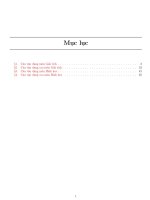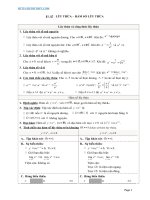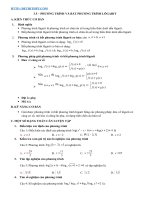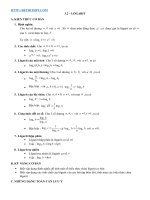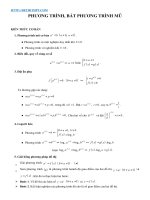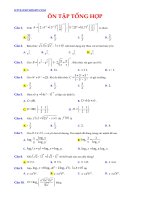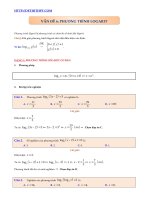BÀI tập VAN DUNG VOI LOI GIAI CHI TIET image marked image marked
Bạn đang xem bản rút gọn của tài liệu. Xem và tải ngay bản đầy đủ của tài liệu tại đây (1.73 MB, 15 trang )
BÀI TẬP – VẬN DỤNG VỚI LỜI GIẢI CHI TIẾT
READING COMPREHENSION 1:
Read the following passage and mark the letter A, B, C to indicate the correct
answer to each of the questions.
While fats have lately acquired a bad image, one should not forget how essential
they are. Fats provide the body's best means of storing energy, far more effiient energy
sources than either carbohydrates or protein. They act as insulation against cold as
cushioning for the internal organs, and as lubricants. Without fats, energy would be no
way to utilize fat soluble vitamins. Furthermore, some fats contain fatty acids that
contain necessary growth factors and help with the digestion of other foods.
An important consideration of fat intake is the ratio of saturated fats to unsaturated
fats. Saturated fats, which are derived from dairy products, animal fats, and tropical
oils, increase the amount of cholesterol in the blood. Cholesterol may lead to coronary
heart disease by building up in the arteries of the heart. However, unsaturated fats,
derived from vegetable oils, tend to lower serum cholesterol if taken in proportion twice
that of saturated fats.
Đăng ký file Word tại link sau
/>
The consumption of a variety of fats is necessary, but the intake of too much fat
may lead to a variety of health problems. Excessive intake of fats, like all nutritional
excesses, is to be avoided.
QUESTIONS
1. The main idea of the fist paragraph is that ____.
(A) fats have a bad image
(B) fats serve important functions in the body
(C) fats store food more effiientlythan proteins or
carbohydrates
2. What is the main idea of the second paragraph?
(A) unsaturated fats may reduce cholesterol levels
Trang 1
(B) the consumption of any type of fat leads to hearts disease
(C) fats taken in the proper proportion may reduce serum cholesterol
3. The main idea of the third paragraph is that
(A) people are eating less and less fat today
(B) fats should be gradually eliminated from the diet
(C) excessive consumption of fats may be dangerous to one's health
4. With which of the following is the whole passage primarily concerned?
(A) the role of fats in human health
(B) the dangers of cholesterol
(C) the benefis of fats in the diet
GIẢI CHI TIẾT
Bài tập này luyện kỹ năng tìm ý chính
Question 1: - Ở ngay câu đầu tiên, "While fats have lately acquired a bad image, one
should not forget how essential they are" chúng ta sẽ hiểu nôm na rằng: "Mặc dù gần
đây chất béo được cho là không có lợi cho sức khỏe, nhưng không thể phủ nhận sự cần
thiết của nó". Không cần dịch ra quá rõ từng chữ, mà quan trọng là chúng ta cần phải
hiểu nội dung người viết muốn truyền tải là gì. Và với cái câu mở đầu như vậy, thì ta
ngầm hiểu cả đoạn sau sẽ đề cập đến những lợi ích của chất béo (fats).
- Các em cần gạch chân dưới tất cả những danh từ được đề cập đến nhiều lần, và điển
hình ở đây là fats, các em sẽ thấy gần như câu nào cũng xuất hiện fats.
- Khi gạch chân các ý chính, ta sẽ thấy là cả đoạn này làm rõ hơn cho câu đầu tiên:
+ provide the body's best means of storing energy (dự trữ năng lượng)
+ act as insulation against cold (cách nhiệt để tránh rét)
+ to utilize fat soluble vitamins (tận dụng vitamin hòa tan)
- Tự định hình nội dung chính của đoạn 1 là: 1 số lợi ích của chất béo
Đáp án: (B) fats serve important functions in the body
Question 2: - Tiếp tục gạch chân dưới từ chính: saturated fats và unsaturated fats.
Người viết hay có xu hướng liệt kê đối tượng A và B, và 1 nửa đoạn nói về đối tượng
A, nửa còn lại nói về đối tượng B.
Trang 2
- Khi đã gạch chân được key words, các em sẽ dễ dàng hiểu được sơ lược nội dung
chính của bài, từ đó khi trả lời tìm thông tin sẽ dễ hơn
=> Saturated fats: increase the amount of cholesterol in the blood
=> không tốt
=> Unsaturated fats: tend to lower serum cholesterol => tot.
Đặc biệt chú ý "proportion twice that of saturated fats" (tiêu thụ 1 lượng gấp đôi so
với saturated fats)
Đáp án: (A) unsaturated fats may reduce cholesterol levels
Question 3: Đáp án: (C) excessive consumption of fats may be dangerous to one's
health (ý trong bài: The consumption of a variety of fats is necessary, but the intake of
too much fat may lead to a variety of health problems. Excessive intake of fats, like all
nutritional excesses, is to be avoided)
Question 4: Đáp án: (A) the role of fats in human health (sau khi đọc nội dung toàn bài
ta có thể suy ra được câu trả lời).
READING COMPREHENSION 2:
Read the following passage and mark the letter A, B, C or D to indicate the answer
to each of the questions
Esperanto is what is called a planned, or artifiial, language. It was created more
than a century ago by Polish eye doctor Ludwik Lazar Zamenhof. Zamenhof believed
that a common language would help to alleviate some of the misunderstandings among
cultures. In Zamenhof's fist attempt at a universal language, he tried to create a
language that was as uncomplicated as possible. This fist language included words such
as ab, ac, ba, eb, be, and ce.This did not result in a workable language in that these
monosyllabic words, though short, were not easy to understand or to retain.
Next, Zamenhof tried a different way of
constructing a simplified language. He made the
words in his language sound like words that people
already knew, but he simplifid the grammar
tremendously. One example of how he simplifid the
language can be seen in the suffies: all nouns in this
language end in o, as in the noun amiko, which
Trang 3
means "friend", and all adjectives end in -a, as in the adjective bela, which means
"pretty". Another example of the simplifid language can be seen in the prefi mal-,
which makes a word opposite in meaning;theword malamiko therefore means "enemy",
and the word "malbela" therefore means "ugly" in Zamenhof's language.
In 1887, Zamenhof wrote a description of this language and published it. He used a
pen name, Dr. Esperanto, when signing the book. He selected the name Esperanto
because this word means "a person who hopes" in his language. Esperanto clubs began
popping up throughout Europe, and by 1950, Esperanto had spread from Europe to
America and Asia. In 1905, the First World Congress of Esperanto took place in
France, with approximately 700 attendees from 20 different countries.
Congresses were held annually for nine years, and 4,000 attendees were registered
for the Tenth World Esperanto Congress scheduled for 1914, when World War I
erupted and forced its cancellation.
Esperanto has had its ups and downs in the period since World War I. Today, years
after it was introduced, it is estimated that perhaps a quarter of a million people are flent
in it. This may seem like a large number, but it is really quite small when compared
with the billion English speakers and billion Mandarin Chinese speakers in today's
world. Current advocates would like to see its use grow considerably and are taking
steps to try to make this happen.
Question 1: The topic of this passage is
A. using language to communicate internationally
B. one man's efforts to create a universal language
C. how language can be improve
D. a language developed in the last few years
Question 2: According to the passage, Zamenhof wanted to create a universal language
A. to provide a more complex language
B. to resolve cultural differences
C. to create one world culture
D. to build a name for himself
Question 3: It can be inferred from the passage that the Esperanto word malespera
means
A. hopelessness
B. hopeless
C. hope
D. hopeful
Trang 4
Question 4: The expression "popping up" paragraph 3 could best be replaced by:
A. hiding
B. shouting
C. leaping
D. opening
Question 5: It can be inferred from the passage that the Third World Congress of
Esperanto took place
A. in 1905
B. in 1907
C. in 1913
D. in 1909
Question 6: According to the passage, what happened to the Tenth World Esperanto
Congress?
A. It had 4,000 attendees
B. It never took place
C. It had attendees from20 countries
D. It was scheduled for 1915
Question 7: The expression "ups and downs" in pragraph 5 is closest in meaning to
A. highs and lows
B. flors and ceilings
C. takeoffs and landings
D. tops and bottoms
Question 8: Which paragraph describes the predecessor to Esperanto?
A. The second paragraph
B. The third paragraph
C. The fist paragraph
D. The fourth paragraph
Question 9: The passage would most likely be assigned reading in a course on
A. applied linguistics
B. European history
C. world government
D. English grammar
Question 10: The paragraph following the passage most likely discusses
A. attempts to reconvene the World Congress of Esperanto in the 1920s
B. the disadvantages of using an artifiial language
C. another of Zamenhof's accomplishments
D. how current supporters of Esperanto are encouraging its growth
GIẢI CHI TIẾT
Question 1 - (MAIN IDEA): The topic of this passage is __________.
A. using language to communicate internationally
Trang 5
B. one man's efforts to create a universal language
C. how language can be improve
D. a language developed in the last few years
Đây là dạng câu hỏi ý chính của đoạn văn. Để làm dạng câu hỏi này, các em áp dụng kỹ
thuật Skimming, đọc lướt đoạn đầu tiên và các câu đầu của các đoạn văn trong bài. Ở
đây, ta thấy bài này nói đến nỗ lực của Zamenhof trong việc tạo nên một ngôn ngữ toàn
cầu → đáp án B
Dịch nghĩa: Chủ đề của bài viết là _________.
A. sử dụng ngôn ngữ để giao tiếp quốc tế
B. nỗ lực của một người để tạo ra ngôn ngữ quốc tế
C. ngôn ngữ có thể được cải thiện như thế nào
D. một ngôn ngữ được phát triển trong vài năm qua
Question 2 - (STATED DETAIL): According to the
passage, Zamenhof wanted to create a universal
language _______________________.
A. to provide a more complex language
B. to resolve cultural differences
C. to create one world culture
D. to build a name for himself
Dịch nghĩa: Theo bài viết, Zamenhofda muốn tạo rơ một ngôn ngữ toàn cầu
A. để cung cấp một thứ ngôn ngữ phức tạp hơn
B. để giải quyết những khó khăn về văn hóa
C. để tạo một văn hóa toàn cầu
D. để tạo nên tên tuổi cho bản thân
Giải thích: Đây là câu hỏi về thông tin cụ thể được nêu ra trong bài khóa. Để làm được
câu hỏi dạng này các em cần áp dụng kỹ thuật scanning, tìm xem dòng nào trong bài có
chứa các key words của câu hỏi "create a universal language" → Đọc câu 2 đoạn 1:
"Zamenhof believed that a common language would help to alleviate some of the
misunderstandings among cultures" -"Zamenhof tin rằng một ngôn ngữ chung có thể
giải quyết một số những bất đồng giữa các nền văn hóa."
→ Đáp án B.
Trang 6
Question 3 - (INFERENCE): It can be inferred from the passage that the Esperanto
word "malespera" means ____.
A. hopelessness
B. hopeless
C. hope
D. hopeful
Dịch nghĩa: Có thể rút ra từ bài viết rằng từ Esperanto "malespera" có nghĩa là
A. sự tuyệt vọng
B. tuyệt vọng
C. hy vọng
D. có hy vọng
Giải thích: Đoạn văn thứ 3 nói đến quy tắc cấu tạo Esperanto:
"all adjectives end in -a"-"tất cả tính từ kết thúc bằng a" và "the prefi mal-, which
makes a word opposite in meaning"-"tiền tố mal-, làm một từ có nghĩa đối lập"
→ Từ malespera chỉ có thể là tính từ hopeless - tuyệt vọng
Question 4 - (VOCABULARY): The expression "popping up" in pragraph 3 could be
best replaced by:
A. hiding
B. shouting
C. leaping
D. opening
Dịch nghĩa: Cụm từ "popping up" ở đoạn 3 có thể được thay thế bởi:
A. che giấu
B. lơ hét
C. nhảy
D. mở rộng
Giải thích: (to) pop up = (to) open: mở rộng, nở rộ
Question 5 - (INFERENCE): It can be inferred from the passage that theThird World
Congress of Esperanto took place.
A. in 1905
B. in 1907
C. in 1913
D. in 1909
Dịch nghĩa: Có thể rút ra từ đoạn văn là Hội nghị toàn cầu lần thứ 3 của Esperanto
diễn ra
A. năm 1905
B. năm1907
C. năm1913
D. năm1909
Giải thích: Đọc đoạn 5 ta thấy: "In 1905, the First World Congress of Esperanto
took place in France... were held annually..."-" Năm 1905, hội nghị quốc tế Esperanto
đẩu tiên đã diễn ra ở Pháp... và nó diễn ra hàng năm..."
→ có thể suy ra hội nghị thứ 3 diễn ra vào năm 1907. Đáp án B.
Question 6 - (STATED DETAIL): According
to the passage, what happened to the Tenth
World Esperanto Congress?
Trang 7
A. It had 4,000 attendees
B. It never took place
C. It had attendees from 20 countries
D. It was scheduled for 1915
Dịch nghĩa: Theo bài viết, điều gì đỏ xảy ra với hội nghị Esperanto toàn cầu lần thứ
10?
A. Đã có 4000 người tham dự
B. Nó đã không bao giờ diễn ra
C. Đã có người tham dự từ 20 quốc gia
D. Nó đã được lên kế hoạch cho năm 1915
Giải thích: Chú ý các key words trong câu hỏi như"the Tenth World Esperanto
Congess"
Đọc câu cuối đoạn 5: "4,000 attendees were registered for the Tenth World Esperanto
Congress scheduled for 1914, when World War I erupted and forced its
cancellation". -"4000 người tham dự đã đăng kí hội nghị Esperanto lần thứ 10 được
lên kế hoạch cho năm 1914, khi Thế chiến thứ nhất đã làm gián đoạn và buộc nó
phải bị hủy bỏ."
Question 7 - (VOCABULARY): The expression "ups and downs" pragraph 5 is
closest in meaning to _______.
A. highs and lows
B. flors and ceilings
C. takeoffs and landings
D. tops and bottoms
Dịch nghĩa: Cụm từ "ups and downs" ở đoạn 5 gân nghĩa nhất với
A. cao và thấp
B. sàn và trần nhà
C. cất cánh và hạ cánh
D. đỉnh và đáy
Giải thích: ups and downs = highs and lows: thăng trầm
Question 8 - (WHERE QUESTION): Which paragraph describes the predecessor to
Esperanto?
A. The second paragraph
B. The third paragraph
C. The fist paragraph
D. The fourth paragraph
Dịch nghĩa: Đoạn văn nào miêu tả tiền thân của Esperanto?
Trang 8
A. Đoạn 2
B. Đoạn 3
C. Đoạn 1
D. Đoạn 4
Giải thích: Đối với câu hỏi dạng này, chúng ta áp dụng kỹ thuật scanning, tìm xem
thông tin về "predecessor" của Esperanto xuất hiện ở đâu trong bài. Đọc đoạn 2 ta thấy
tác giả đã nói đến nỗ lực đầu tiên của Zamenhof đã tạo ra một thứ ngôn ngữ đơn giản
nhưng không thể sử dụng được → đó chính là tiền thân của Esperanto
Question 9 - (INFERENCE): The passage would most likely be assigned reading in a
course on ________.
Dịch nghĩa: Bài viết có thể được giao cho đọc trong khóa học về
A. ngôn ngữ học ứng dụng
B. lịch sử Châu Âu
C. chính phủ thế giới
D. ngữ pháp Tiếng Anh
Giải thích: Áp dụng kỹ thuật skimming, ta thấy bài viết chủ yếu thảo luận về sự hình
thành và phát triển của một ngôn ngữ mới → Đáp án A là chính xác.
Question 10 - (INFERENCE): The paragraph following the passage most likely
discusses
A. attempts to reconvene the World Congress of Esperanto in the 1920s
B. the disadvantages of using an artifiiaI language
C. another of Zamenhof's accomplishments
D. how current supporters of Esperanto are encouraging its growth
Dịch nghĩa: Đoạn văn tiếp theo bài viết có thể thảo luận về
A. những cố gắng để khôi phục Nghị viện toàn cầu về Esperanto những năm 1920
B. những bất lợi của việc sử dụng một ngôn ngữ do con người tạo ra
C. một thành tựu khác của Zamenhof
D. những người ủng hộ Esperanto đang củng cố sự phát triển của nó như thế nào
Để làm được dạng câu hỏi này, các em cần nắm được ý chính của bài và đọc kỹ đoạn
cuối để tìm mối liên hệ với đoạn kế tiếp. Đọc câu cuối bài viết: "Current advocates
would like to see its use grow considerably and are taking steps to try to make this
happen."-"Những người ủng hộ ngày nay muốn thấy việc sử dụng nó phát triển mạnh
mẽ và đang từng bước cố gắng thực hiện điều này".
→ Có thể suy ra rằng đoạn văn tiếp theo sẽ nói tiếp về những cố gắng của những người
ủng hộ hiện nay
Trang 9
Sau khi làm xong một bài đọc hiểu, các em tham khảo phần dịch bài trong sách để quen
với các từ mới xuất hiện trong bài. Càng biết nhiều từ mới, phần làm dạng bài đọc hiểu
sẽ càng trở nên dễ dàng hơn.
DỊCH BÀI
Esperanto là một ngôn ngữ được lên kế
hoạch, hay do con người tạo ra. Nó đã được phát
minh từ hơn một thế kỉ trước bởi một bác sĩ mắt
người Phần Lan có tên là Ludwik Lazar
Zamenhof. Zamenhof tin rằng một ngôn ngữ
chung có thể giải quyết một số bất đồng giữa các
văn hóa.
Trong nỗ lực đầu tiên của Zamenhof nhằm tạo ra một ngôn ngữ toàn cầu, ông đã cố
gắng tạo ra một ngôn ngữ càng không phức tạp càng tốt. Ngôn ngữ đầu tiên bao gồm
những từ như ab, ac, ba, eb, be và ce. Điều này đã không tạo nên một thứ ngôn ngữ sử
dụng được với những từ đơn âm tiết như vậy, mặc dù ngắn, nhưng không dễ hiểu và dễ
duy trì.
Sau đó, Zamenhof đã thử một cách khác để cấu tạo một ngôn ngữ đơn giản, ông
làm những từ trong ngôn ngữ của mình nghe giống những từ mọi người đã biết, nhưng
ngữ pháp được đơn giản hóa đáng kể. Một ví dụ về cách mà ông đã đơn giản hóa ngôn
ngữ có thể thấy ở những hậu tố: tất cả những danh từ trong ngôn ngữ này kết thúc bằng
o, như từ amiko, nghĩa là "bạn bè", và tất cả tính từ kết thúc bằng a, như trong từ bela,
nghĩa là "dễ thương". Một ví dụ khác về ngôn ngữ được đơn giản hóa có thể thấy trong
tiền tố mal-, làm một từ có nghĩa đối lập; từ malamiko vì thế nghĩa là "kẻ thù", và từ
malbela vì thế nghĩa là xấu xí trong ngôn ngữ của Zamenhof.
Năm 1887, Zamenhof viết một bản mô tả ngôn ngữ của ông và đem xuất bản nó.
Ông đã dùng bút danh "tiến sĩ Esperanto" khi kí tên cho cuốn sách, ông chọn cái tên
Esperanto vì từ này có nghĩa là "một người hy vọng" trong ngôn ngữ của ông ấy.
Những câu lạc bộ Esperanto bắt đầu nở rộ ở khắp Châu Âu, và đến năm 1950,
Esperanto đã lan truyền từ Châu Âu đến châu Mỹ và châu Á.
Năm 1905, hội nghị quốc tế Esperanto đầu tiên đã diễn ra ở Pháp, với khoảng 700
người tham dự đến từ 20 quốc gia khác nhau. Những hội nghị đã được tổ chức hàng
năm trong 9 năm, và 4000 người tham dự đã đăng kí hội nghị Esperanto lần thứ 10
Trang 10
được lên kế hoạch cho năm 1914, khi Thế chiến thứ nhất đã làm gián đoạn và buộc nó
phải bị hủy bỏ.
Esperanto có những thăng trầm của nó trong khoảng thời gian thế chiến thứ nhất.
Ngày nay, nhiều năm sau khi được giới thiệu, ước lượng khoảng 1/4 triệu người thông
thạo ngôn ngữ này. Đây có thể coi là một con số lớn, nhưng nó khá nhỏ khi so sánh với
hàng triệu người nói tiếng Anh và hàng triệu người nói tiếng Trung Quốc trên thế giới
hiện nay. Những người ủng hộ Esperanto ngày nay muốn thấy việc sử dụng nó phát
triển mạnh mẽ và đang từng bước cố gắng thực hiện điều này.
READING COMPREHENSION 3:
Read the following passage and mark the letter A, B, C, or D to indicate the
correct answer to each of the questions.
Herman Melville, an American author best known today for his novel Moby Dick,
was actually more popular during his lifetime for some of his other works. He traveled
extensively and used the knowledge gained during his travels as the basis for his early
novels. In 1837, at the age of eighteen, Melville signed as a cabin boy on a merchant
ship that was to sail from his Massachusetts home to Liverpool, England. His
experiences on this trip served as a basis for the novel Redburn (1849). In 1841,
Melville set out on a whaling ship headed for the South Seas. After jumping ship in
Tahiti, he wandered around the islands of Tahiti and Moorea.This South Sea island
sojourn was a backdrop to the novel Omoo (1847). After three years awayfrom home,
Melville joined up with a U.S. naval frigate that was returning to the eastern United
States around Cape Horn. The novel White Jacket (1850) describes this lengthy voyage
as a navy seaman.
With the publication of these early adventure novels, Melville developed a strong
and loyal following among readers eager for his tales of exotic places and situations.
However, in 1851, with the publication of Moby Dick, Melville's popularity started to
diminish. Moby Dick, on one level the saga of the hunt for the great white whale, was
also a heavily symbolic allegory of the heroic struggle of humanity against the universe.
The public was not ready for Melville's literary metamorphosis from romantic
adventure to philosophical symbolism. It is ironic that the novel that served to diminish
Melville's popularity during his lifetime is the one for which he is best known today.
QUESTIONS
Question 1: The main subject of the passage is ____.
A. Melville's travels
B. the popularity of Melville's novels
Trang 11
C. Melville's personal background
D. Moby Dick
Question 2: According to the passage, Melville's early novels were _______.
A. published while he was traveling
B. completely fitional
C. all about his work on whaling ships
D. based on his travel experience
Question 3: In what year did Melville's book about his experiences as a cabin boy
appear?
A. 1837
B. 1841
C. 1847
D. 1849
Question 4: The word "basis" in paragraph 1 is closest in meaning to
A. background
B. message
C. bottom
D. dissertation
Question 5: The passage implies that Melville stayed in Tahiti because _______.
A. he had unoffiially left his ship
B. he was on leave while his ship was in port
C. he had fiished his term of duty
D. he had received permission to take a vacation in Tahiti
Question 6: A "frigate" in paragraph 1 is probably ___________.
A. anoffie
B. a ship
C. a troop
D. a fihing boat
Question 7: How did the publication of Moby Dick affect Melville's popularity?
A. His popularity increased immediately.
B. It had no effect on his popularity.
C. It caused his popularity to decrease.
D. His popularity remained as strong as ever
Question 8: According to the passage, Moby Dick is_______.
A. a romantic adventure
B. a single-faceted work
C. a short story about a whale
Trang 12
D. symbolic of humanity fihting the universe
Question 9: The word "metamorphosis" in paragraph 2 is closest in meaning to
A. circle
B. change
C. mysticism
.
D. descent
Question 10: The passage would most likely be assigned reading in a course on
_____.
A. nineteenth-century novels
B. American history
C. oceanography
D. modem American literature
GIẢI CHI TIẾT
Question 1: MAIN IDEA QUESTION
Câu hỏi này nên để làm cuối cùng sau khi đã đọc lướt qua toàn bài và tập trung vào một
số câu hỏi chi tiết để hiểu về nội dung của toàn bài hơn.
Đáp án: B (Tính phổ biến của tiểu thuyết Melville)
Ý trong bài: (Herman Melville, an American author best known today for his novel
Moby Dick, was actually more popular during his lifetime for some of his other works)
(With the publication of these early adventure novels, Melville developed a strong and
loyal following among readers eager for his tales of exotic places and situations.
However, in 1851, with the publication of Moby Dick, Melville's popularity started to
diminish.)
Trang 13
Question 2: STATED DETAIL QUESTION
Đáp án D: dẫn chứng (He traveled xtensively and used the knowledge gained during his
travels as the basis for his early novels)
Phương án A sai vì không được đề cập trong bài. Phương án B sai vì các tác phẩm đều
dựa’ trên kinh nghiệm của ông. Phương án c sai vì các tiểu thuyết đầu tay của ông nói
về các chuyến đi đến vùng nam Thái Bình Dương - the south Seas đến Tahiti.
Question 3: STATED DETAIL QUESTION
Đáp án D: His experiences on this trip served as a basis for the novel Redburn (1849).
Question 4: VOCABULARY QUESTION
Đáp án A: basis = background
Question 5: STATED DETAIL QUESTION
Đáp án A: Ý trong bài (After jumping ship in Tahiti, he wandered around the islands of
Tahiti and Moorea)
Question 6: VOCABULARY QUESTION
Đáp án B: Ý trong bài (Melville joined up with a U.S. naval frigate that was returning
to the eastern United States)
Question 7: STATED DETAIL QUESTION
Đáp án C dẫn chứng trong bài (with the publication of Moby Dick, Melville's
popularity started to diminish)
Question 8:
Đáp án D dẫn chứng trong bài (Moby Dick, on one level the saga of the hunt for the
great white whale, was also a heavily symbolic allegory of the heroic struggle of
humanity against the universe.)
Question 9: VOCABULARY QUESTION
Đáp án B metamorphosis = change
Trang 14
Suy luận trong bài từ ý (metamorphosis from romantic adventure to philosophical
symbolism: sự thay đổi từ tiểu thuyết phưu lưu tình cảm đến chủ nghĩa tượng trưng
mang tính triết học)
Question 10: MAIN IDEA QUESTION
Đáp án A (các tiểu thuyết thế kỷ 19)
Trang 15
